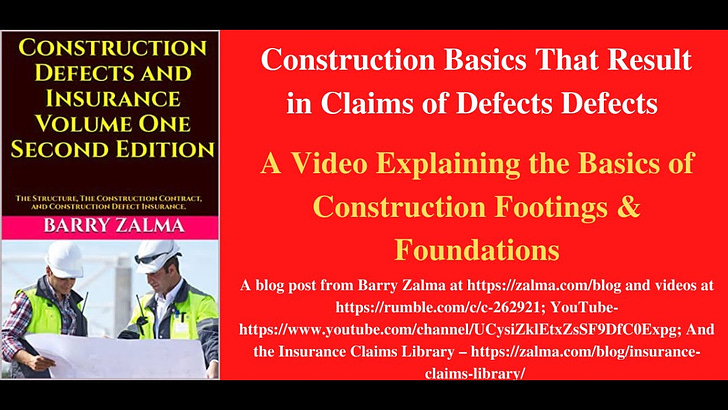A Video Explaining the Basics of Construction Footings & Foundations
Construction Basics That Result in Claims of Defects Defects
Read the full article at https://www.linkedin.com/pulse/construction-basics-result-claims-defects-barry-zalma-esq-cfe and see the full video at https://rumble.com/vqhcx6-construction-basics-that-result-in-claims-of-defects-defects.html and at
and at https://zalma.com/blog plus more than 4000 posts.
To understand the construction defect claim and the litigation surrounding construction defects, it is necessary to first have a basic understanding of construction, what is proper and prudent and what can go wrong.
Building codes prescribe basic standards. When these standards are not followed, or not followed carefully enough, a building can fail. It may leak or lean or even fall down.
The following discussion offers a brief overview of the component parts of a standard dwelling built of wood framing using common construction methods used over the last century, and the problems that can arise when any part of the building fails.
To make things simple, the discussion below focuses on the single-family dwelling. Multi-family and commercial buildings are larger, have more parts, and are much more complex to construct. Newer building materials and techniques are not discussed, nor are factory-built homes.
Note that modern buildings may use steel in place of lumber in the framing, artificial rather than cement-based stucco, computer controls for electrical appliances and heating, ventilating and air-conditioning systems, and other modern materials and construction techniques. Regardless of the materials and techniques used in construction, the points at which the structure may fail are essentially the same.
Typical single-family homes built during the last century were constructed with a wood frame built on top of a concrete foundation. The foundations are either raised on piers or poured flat on grade. The lumber that makes up the wood frame is usually jacketed with lath (thin wood strips) or a moisture barrier paper with a wire covering that is covered with stucco (a durable porous concrete product), exterior insulation and finish systems (artificial stucco) or wood or vinyl siding. The interior walls are usually finished with drywall (gypsum covered in paper that, when finished, gives the appearance of lath and plaster) or, in older structures, wood lath and plaster.
Basic single-family dwellings are usually one to two stories in height and range from 900 to 3,500 square feet. Of course, there are also “mansions” where a single family may reside in a 20,000 square foot structure and “McMansions” that range from 3,500 to 10,000 square feet built on lots where most homes are the simple single family homes of 900 to 1,500 square feet. It is becoming common to remodel old dwellings of 900 – 1100 square feet into 5,000 to 10,000 square foot dwellings on small residential lots. These extreme remodeling efforts often run afoul of claims of code violations and construction defect.
All three varieties are available at https://amazon.com
© 2021 – Barry Zalma
Barry Zalma, Esq., CFE, now limits his practice to service as an insurance consultant specializing in insurance coverage, insurance claims handling, insurance bad faith and insurance fraud almost equally for insurers and policyholders.
He also serves as an arbitrator or mediator for insurance related disputes. He practiced law in California for more than 44 years as an insurance coverage and claims handling lawyer and more than 54 years in the insurance business.
Subscribe to Excellence in Claims Handling at https://barryzalma.substack.com/welcome.
He is available at http://www.zalma.com and zalma@zalma.com. Mr. Zalma is the first recipient of the first annual Claims Magazine/ACE Legend Award. Over the last 53 years Barry Zalma has dedicated his life to insurance, insurance claims and the need to defeat insurance fraud. He has created the following library of books and other materials to make it possible for insurers and their claims staff to become insurance claims professionals.
Go to training available at https://claimschool.com; articles at https://zalma.substack.com, the podcast Zalma On Insurance at https://anchor.fm/barry-zalma; Follow Mr. Zalma on Twitter at https://twitter.com/bzalma; Go to Barry Zalma videos at https://www.rumble.com/zalma ; Go to Barry Zalma on YouTube- https://www.youtube.com/channel/UCysiZklEtxZsSF9DfC0Expg; Go to the Insurance Claims Library – https://zalma.com/blog/insurance-claims-library/ The last two issues of ZIFL are available at https://zalma.com/zalmas-insurance-fraud-letter-2/ podcast now available at





